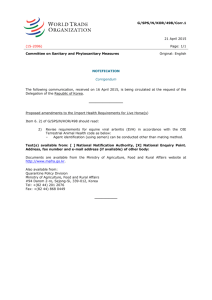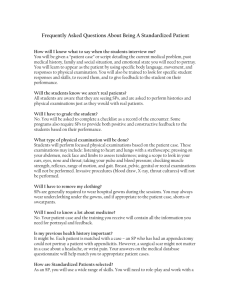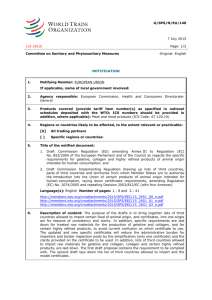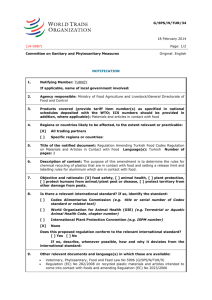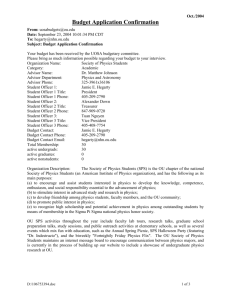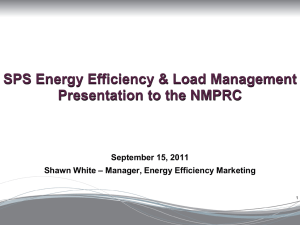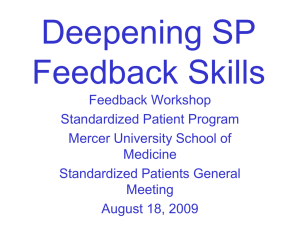Monthly E-Risk Newsletter to
advertisement
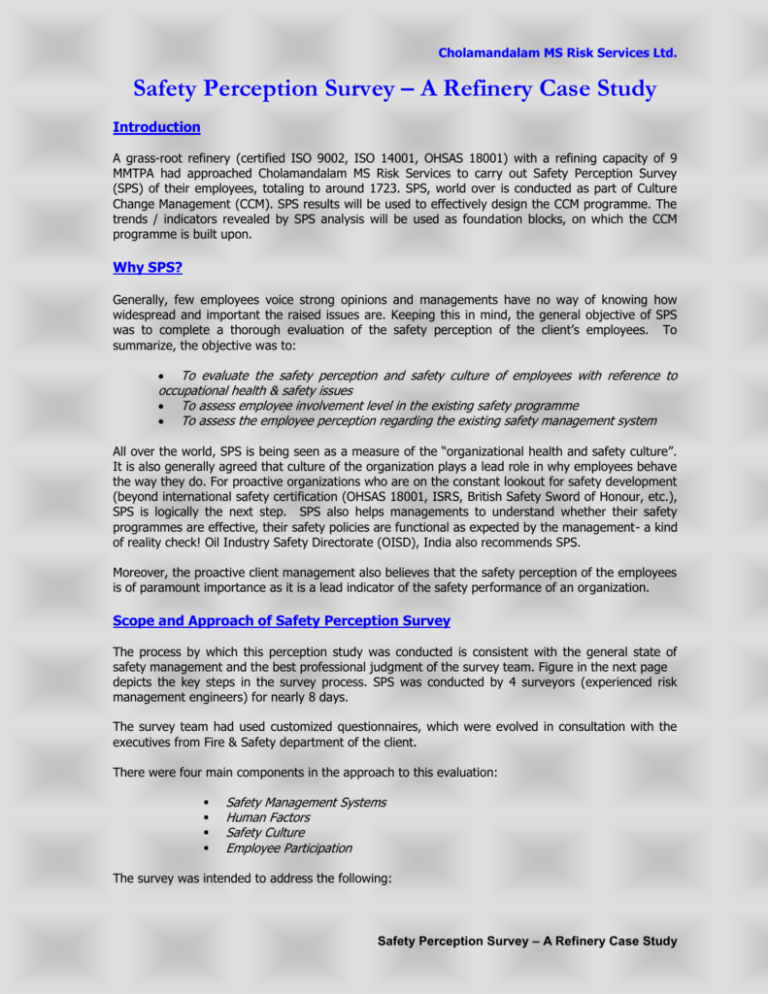
Cholamandalam MS Risk Services Ltd. Safety Perception Survey – A Refinery Case Study Introduction A grass-root refinery (certified ISO 9002, ISO 14001, OHSAS 18001) with a refining capacity of 9 MMTPA had approached Cholamandalam MS Risk Services to carry out Safety Perception Survey (SPS) of their employees, totaling to around 1723. SPS, world over is conducted as part of Culture Change Management (CCM). SPS results will be used to effectively design the CCM programme. The trends / indicators revealed by SPS analysis will be used as foundation blocks, on which the CCM programme is built upon. Why SPS? Generally, few employees voice strong opinions and managements have no way of knowing how widespread and important the raised issues are. Keeping this in mind, the general objective of SPS was to complete a thorough evaluation of the safety perception of the client’s employees. To summarize, the objective was to: To evaluate the safety perception and safety culture of employees with reference to occupational health & safety issues To assess employee involvement level in the existing safety programme To assess the employee perception regarding the existing safety management system All over the world, SPS is being seen as a measure of the “organizational health and safety culture”. It is also generally agreed that culture of the organization plays a lead role in why employees behave the way they do. For proactive organizations who are on the constant lookout for safety development (beyond international safety certification (OHSAS 18001, ISRS, British Safety Sword of Honour, etc.), SPS is logically the next step. SPS also helps managements to understand whether their safety programmes are effective, their safety policies are functional as expected by the management- a kind of reality check! Oil Industry Safety Directorate (OISD), India also recommends SPS. Moreover, the proactive client management also believes that the safety perception of the employees is of paramount importance as it is a lead indicator of the safety performance of an organization. Scope and Approach of Safety Perception Survey The process by which this perception study was conducted is consistent with the general state of safety management and the best professional judgment of the survey team. Figure in the next page depicts the key steps in the survey process. SPS was conducted by 4 surveyors (experienced risk management engineers) for nearly 8 days. The survey team had used customized questionnaires, which were evolved in consultation with the executives from Fire & Safety department of the client. There were four main components in the approach to this evaluation: Safety Management Systems Human Factors Safety Culture Employee Participation The survey was intended to address the following: Safety Perception Survey – A Refinery Case Study Cholamandalam MS Risk Services Ltd. Management and Line Organization Commitment to Safety Personal Involvement in Safety Training, Competence and Awareness of Responsibilities Perception towards Accidents / Incidents and their reporting system Efforts were made towards sampling major facets of safety management, but it is important to recognize that this method is intended to uncover major system deficiencies and the evaluation may not have identified all potential strengths and weaknesses. Key Steps in the Safety Perception Survey Process: Pre Survey Activities Defining the scope and methodology of the survey Onsite Survey Activities Post Survey Activities Survey Kick off meeting with the HODs of various Departments to explain the objective and methodology Development of customized software to capture the data gathered during the survey Discussion with client to identify the key elements, categories of employees and the sampling percentage Grouping of Survey team – Focus on various departments Scientific Analysis of the structured data Evolution of Questionnaire for various categories of the employees Personal Interaction with the employees across all the categories to gather information detailed in the questionnaire Interpretation of data and documentation of findings as Draft Report – For comments from client Pre Survey meeting with client to finalize the questionnaire Daily briefing of the personal interactions Close out meeting to brief client Top management on survey findings Final Report incorporating suggestions / comments SPS Elements: After extensive deliberations (internal and with the client), 17 elements were included in the SPS questionnaire, under 4 broad categories: SAFETY LEADERSHIP SAFETY MANAGEMENT SAFETY CULTURE SAFETY PROMOTION Safety Perception Survey – A Refinery Case Study Cholamandalam MS Risk Services Ltd. Employee Categorization: The refinery employees were grouped based on their cadre / nature of operations so that the developed SPS questionnaire were relevant in consultation with the client management. This grouping helped the survey team to develop specific questionnaire for each of the categories. Category 1 Category 2 (Top Management) Directors Executive Director Category 3 (Senior and middle Management) General Manager Dy. General Manager Chief Manager Senior Manager Manager Deputy Manager Senior Engineer Engineer Field Operators Maintenance Technicians Category 4 Contractor Employees SPS Questionnaire Development: After agreeing on the main and sub elements of the questionnaire, the survey team drafted the questionnaire, one for each category. Various sub elements for each of the 17 elements were developed based on survey team’s expertise & client’s operations. Although questionnaires were designed separately for each of the categories, the sub elements were kept same to have overall parity. The SPS also recorded the employee comments / suggestions in the questionnaire as suggested by the client. The following employee details were also recorded in the employee questionnaire to help during the process of data analysis: Designation / Cadre: Number of years of experience: Department: Date & Time of Survey: Selection of sub-elements for SPS elements can be best understood by the following example: SPS Element: Emergency Management Sub-Elements: Effectiveness Awareness Emergency Communication Updation of Emergency Management Plan Confidence in emergency preparedness Mock drill participation Safety Perception Survey – A Refinery Case Study Cholamandalam MS Risk Services Ltd. Category No of questions Category 1 54 Category 2 93 Category 3 86 Category 4 69 SPS Sampling: The survey team decided on the SPS sampling percentage in consultation with the refinery management. Employee Category 1 2 3 4 Total Number of employees Sampling Percentage 6 67 593 15 1108 10 Total Number of employees Surveyed Number of employees surveyed 4 89 110 16 219 Note: In category 4, employees from 7 contractors (civil, electrical, mechanical) were interviewed. SPS Coverage: As part of SPS, employees from the following refinery departments were surveyed. Fire & Safety Projects R&D LPG Plant DHDS Crude I, II Plants OHS Centre Technical Services Maintenance (Electrical, mechanical, instrumentation) Oil Movement & Storage (Tank Farm) SPS Auditors’ Profile: The survey team consisted of experienced safety professionals who have executed a variety of safety and risk management projects for reputed industries in the oil and gas sector. SPS Analysis Software: Software was developed by CMSRSL to capture and analyze the SPS data. The software provided tremendous flexibility to perform desired analysis in various combinations. The software could also Safety Perception Survey – A Refinery Case Study Cholamandalam MS Risk Services Ltd. generate graphs for various comparisons (within the employee categories, across categories, etc.). Use of software resulted in scientific analysis of data with accuracy. A snap shot of the software is depicted in the next page. Employee Comments: SPS also captured the employee comments in the survey questionnaire and the valuable, practical employees suggestions were grouped under 12 categories (Safety Management System, Emergency Management, Occupational Health, Accident Investigation, Contractor Safety, etc.). Some of the interesting employee suggestions are given below: Change location of safety posters to be done to retain interest Whenever any critical maintenance activity is carried out, on site supervision from safety department is required Frequent plant visit of senior management personnel & interaction with operators to be revived No specific scenarios envisaged for the tall CDU structure fires EMP needs to be communicated to all levels and ensured that it reaches the lowest level Employee empowerment to be defined and communicated Contractor employees to be allowed inside refinery with a safety-training card (with a minimum of safety training). Mostly, under size or over size safety shoes are provided Management should share the findings of the accidents SPS Analysis & Report: Survey team made all possible efforts to ensure that evaluation was impartial and objective. However, because findings do reflect perceptions, they may not be indicative of “reality”, and there may be apparent conflicts between the factual evidence gained as part of safety management system evaluation and the anecdotal evidence gathered from interviews with employees. Sample snap shots of the graphs generated out of the SPS data are given below. Safety Perception Survey – A Refinery Case Study Cholamandalam MS Risk Services Ltd. 100 90 86.96 100 C 1 C O M M U N IC A T IO N 90 80 80.51 80 70 70 65.34 60 77.77 77.07 73.12 71.91 66.84 1 9% 61.25 68.63 73.15 77.13 75.71 78.7 72.71 71.83 68.09 60 2 9% 3 0% 50 50 40 42.01 40 30 20 30 10 4 82% 20 10 0 SAFETY CONCERNS C1 SAFETY CONCERNS C2 SAFETY CONCERNS C3 SAFETY CONCERNS C4 86.96 65.34 42.01 61.25 Average Yes Score 0 ACCIDENT INVESTIGATION EMERGENCY MANAGEMENT EMPLOYEE TRAINING INSPECTI ONS NEW EMPLOYEE OH_S SAFETY CONCERNS C2 71.91 68.63 80.51 73.15 71.83 77.13 78.7 C3 66.84 77.77 73.12 68.09 77.07 75.71 72.71 The survey team decided on the various comparisons. Based on the graphs generated, various interpretations were drawn so that the refinery management can take action. The refinery management was supposed to draw up an action plan based on the SPS report. The employee comments (extracted from SPS questionnaire) were grouped under various SPS elements and was attached along with the SPS report. Acceptable Safety Perception Level (ASPL): ASPL, a term coined by the survey team, is the acceptable level of safety perception set at 80 (a thick black bar represents ASPL in the graphs). ASPL is not a benchmark and ideally the score should be 100. The score above or below does not indicate that either the element meets or does not meets standards. It is a line that is assumed to facilitate and draw inferences across groups. About Us: Cholamandalam MS Risk Services Limited (CMSRSL) is a premier Safety & Risk Management organization (a Joint Venture between Mitsui Sumitomo Insurance Group & Murugappa Group) providing consultancy & training services to industry & service sectors in India & rest of Asia. Safety Perception Survey is one of the specialized services offered by CMSRSL and to have more information on this service or any of our risk management services, please write sreejithPG@chola.murugappa.com. Address: P.G. Sreejith Manager (Risk Services) Cholamandalam MS Risk Services Ltd., Dare House, II Floor, 234, NSC Bose Road, Parrys, Chennai –600 001, India Ph: + 91 44 2530 7431 Fax: + 91 44 5216 6001 Mobile # + 91 98403 58300 Safety Perception Survey – A Refinery Case Study
